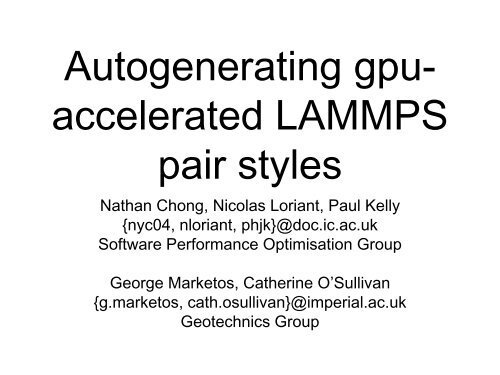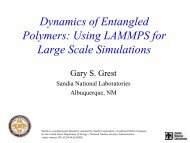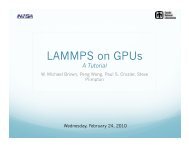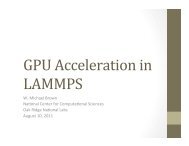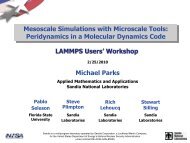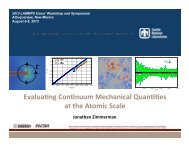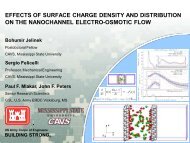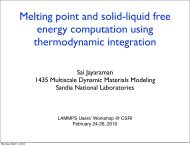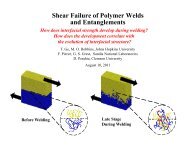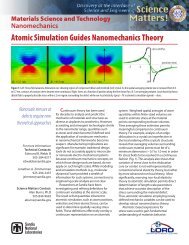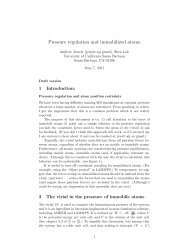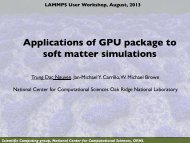Autogenerating gpu-accelerated LAMMPS pair styles
Autogenerating gpu-accelerated LAMMPS pair styles
Autogenerating gpu-accelerated LAMMPS pair styles
Create successful ePaper yourself
Turn your PDF publications into a flip-book with our unique Google optimized e-Paper software.
<strong>Autogenerating</strong> <strong>gpu</strong><strong>accelerated</strong><br />
<strong>LAMMPS</strong><br />
<strong>pair</strong> <strong>styles</strong><br />
Nathan Chong, Nicolas Loriant, Paul Kelly<br />
{nyc04, nloriant, phjk}@doc.ic.ac.uk<br />
Software Performance Optimisation Group<br />
George Marketos, Catherine O’Sullivan<br />
{g.marketos, cath.osullivan}@imperial.ac.uk<br />
Geotechnics Group
Connectivity<br />
Connectivity<br />
Connectivity<br />
Doing experiments...<br />
20<br />
10<br />
20<br />
10<br />
Page 2<br />
Stable dam filter<br />
0<br />
Connectivity =<br />
number of contacts<br />
a particle has with<br />
other contacts<br />
Unstable dam filter<br />
0<br />
Using DEM to develop a rational basis for dam<br />
filter design<br />
2
vs. writing experiments<br />
__global__ void bpp_compute_kernel(<br />
int nparticles,<br />
#ifdef AOS_LAYOUT<br />
struct particle *particle_aos,<br />
#else<br />
struct particle particle_soa,<br />
#endif<br />
int *numneigh, double *force, double *torque<br />
#ifdef NEWTON_THIRD<br />
, double3 *fdelta, double3 *tdeltaj<br />
#endif ) {<br />
__shared__ double ftmp[NSLOT*3];<br />
__shared__ double ttmp[NSLOT*3];<br />
int jj = threadIdx.x; int idx = blockIdx.x;<br />
if (idx < nparticles && jj < numneigh[idx]) { ... }<br />
3
Implementation details<br />
• CPU or GPU?<br />
• Choice of decomposition<br />
• Data-layout and orchestration<br />
• Algorithm tradeoffs<br />
• Effective use of resources<br />
4
Hardware choices<br />
• Intel SCCC, MIC<br />
• AMD Fusion<br />
• NVIDIA Fermi, Kepler, Maxwell<br />
5
Opportunity for Software<br />
Optimization Group<br />
• Targeting granular community of<br />
<strong>LAMMPS</strong><br />
• Make it easy to write <strong>pair</strong> <strong>styles</strong> that<br />
execute with good performance on a<br />
variety of hardware platforms<br />
6
Key idea: abstraction<br />
• Separate specification and<br />
implementation<br />
• <strong>pair</strong>wise interaction (mechanical<br />
model)<br />
• data/access pattern<br />
• implementation details (eg, how to<br />
decompose the problem onto parallel<br />
hardware)<br />
7
Related work<br />
• Molecular Dynamics: OpenMM, NAMD<br />
• Unstructured Grid: OP2, Liszt<br />
• Other: SPIRAL, FFTW, ATLAS<br />
8
The NxM problem<br />
LJ Hertz Hooke GB<br />
LJ Hertz Hooke GB<br />
multicore/avx implementations<br />
LJ Hertz Hooke GB<br />
cuda <strong>gpu</strong> implementations<br />
9
Abstraction<br />
LJ Hertz Hooke GB<br />
Simple, abstract<br />
specifications<br />
<strong>pair</strong>gen<br />
LJ Hertz Hooke GB<br />
multicore/avx implementations<br />
LJ Hertz Hooke GB<br />
cuda <strong>gpu</strong> implementations<br />
10
Step 1. Create parameter file<br />
name: hertz<br />
parameters:<br />
- name: x<br />
type: double<br />
arity: 3<br />
set: P<br />
access: RO<br />
- name: v<br />
- name: omega<br />
- name: radius<br />
arity: 1<br />
- name: mass<br />
arity: 1<br />
name: type<br />
arity: 1<br />
type: int<br />
11<br />
- name: force<br />
access: SUM<br />
- name: torque<br />
access: SUM<br />
- name: shear<br />
set: N<br />
access: RW<br />
constants:<br />
- name: dt<br />
- name: nktv2p<br />
- name: yeff<br />
- name: geff<br />
- name: betaeff
Step 1. Create parameter file<br />
We invoke <strong>pair</strong>gen at<br />
the command line:<br />
$ <strong>pair</strong>gen.py hertz.yml<br />
12
Step 2. Add detail to generated code<br />
__device__ void hertz_<strong>pair</strong>_kernel(<br />
double xi[3], double xj[3],<br />
double vi[3], double vj[3],<br />
double omegai[3], double omegaj[3],<br />
double radiusi, double radiusj,<br />
double massi, double massj,<br />
int typei, int typej,<br />
double forcei_delta[3],<br />
double torquei_delta[3],<br />
double shear[3],<br />
int *touch) {<br />
}<br />
//fill me in<br />
hertz_kernel.cu<br />
13
tep 3. Autogenerated <strong>pair</strong>gen<br />
output (implementation)<br />
__global__ void bpp_compute_kernel(<br />
int nparticles,<br />
#ifdef AOS_LAYOUT<br />
struct particle *particle_aos,<br />
#else<br />
struct particle particle_soa,<br />
#endif<br />
int *numneigh, double *force, double *torque<br />
#ifdef NEWTON_THIRD<br />
, double3 *fdelta, double3 *tdeltaj<br />
#endif ) {<br />
__shared__ double ftmp[NSLOT*3];<br />
__shared__ double ttmp[NSLOT*3];<br />
int jj = threadIdx.x; int idx = blockIdx.x;<br />
if (idx < nparticles && jj < numneigh[idx]) { ... }<br />
14
Experimental evaluation<br />
• Simulation data taken from raining of<br />
particles into a box under gravity<br />
• Constant number of particles, 45.6K<br />
• Number of neighbors increases as<br />
simulation proceeds<br />
• Vary number of neighbors for problem<br />
size<br />
15
Implementations<br />
Using <strong>pair</strong>gen<br />
Neighbor list<br />
datastructure<br />
Decomposition<br />
Neighbor<br />
list<br />
serial None n/a Half<br />
dnl Dense-neighbor Thread per neighbor Half<br />
tpp-full Sparse-neighbor Thread per particle Full<br />
bpp-full Sparse-neighbor Block per particle Full<br />
tpp-half Sparse-neighbor Thread per particle Half<br />
bpp-half Sparse-neighbor Block per particle Half<br />
17
Runtime costs<br />
18
Conclusions<br />
• Make it easy to write <strong>pair</strong> <strong>styles</strong> that<br />
execute with good performance on a<br />
variety of hardware platforms<br />
• Pairgen addresses abstraction and<br />
performance (but not yet performance<br />
portability)<br />
19
Future work<br />
• Modifying <strong>pair</strong>gen to achieve a dense neighbour<br />
implementation (ongoing)<br />
• Generating implementations for different hardware<br />
• Extending this domain-specific approach to other<br />
parts of the <strong>LAMMPS</strong> simulation loop (in particular,<br />
fixes).<br />
• Dynamically switching between implementation<br />
choices as simulation characteristics change<br />
20
Nathan Chong<br />
• http://www.doc.ic.ac.uk/nyc0<br />
4/<br />
• nyc04@doc.ic.ac.uk<br />
• Please email for information<br />
on test driving <strong>pair</strong>gen!<br />
21
Experiment details<br />
23
Toolset<br />
Version<br />
Flags<br />
g++ 4.4.3 -O2<br />
nvcc 3.2 -arch sm_13<br />
24
Hardware<br />
• Intel P4 3.6GHz<br />
• 2GB memory<br />
• NVidia GeForce GTX 480 (Fermi)<br />
• 1.5GB global memory<br />
• 15 multiprocessors/120 cores<br />
25


